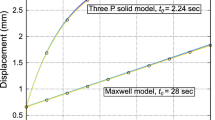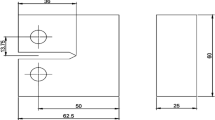Abstract
A method of inverse finite element analysis is used to determine the constitutive relationship of SFRC in tension, using primary experimental data. Based on beam bending test results and results from pull-out tests, an attempt is made to explain the physical processes taking place during the cracking stage. Basic models predicting the behaviour of SFRC in tension are proposed.
Similar content being viewed by others
References
RILEM TC 162-TDF (2000) Test and design methods for steel fibre reinforced concrete: σ − ε design method. Materials and Structures 33(226):75–81.
RILEM TC 162-TDF (2003) Test and design methods for steel fibre reinforced concrete. σ − ε design method. Final recommendation. Materials and Structures 36(262):560–567.
Vandewalle L, Dupont D (2003) Bending tests and interpretation, in Test and design methods for steel fibre reinforced concrete–-background and experiences. Proceedings of the RILEM TC 162-TDF Workshop, Bochum. March 2003 (RILEM S.A.R.L., Bagneux) pp. 1–13.
RILEM TC 162-TDF (2002) Test and design methods for steel fibre reinforced concrete: σ-w method: principles and applications. Materials and Structures 35(249):262–278.
RILEM TC 162-TDF (2001) Test and design methods for steel fibre reinforced concrete: uni-axial tension test for steel fibre reinforced concrete. Materials and Structures 34(235):3–6.
RILEM TC 162-TDF (2002) Test and design methods for steel fibre reinforced concrete: bending test. Materials and Structures 35(253):579–582.
Barr B, Lee MK (2002) Interpretation in the procedure of calculating RILEM TC-162 beam design Parameters. Definition of round robin test, preparation of specimens, execution and evaluation of round Robin testing. Report of subtasks 2.1 and 2.2′, Brite-Euram project BRPR-CT98-0813: Test and design methods for steel fibre reinforced concrete, project funded by the European Community under the Industrial & Materials Technologies Programme (Brite-Euram II).
Tlemat H, Pilakoutas K, Neocleous K (2005) Stress-strain characteristic of SFRC using recycled fibres. Materials and Structures, in press June.
Hemmy O (2002) ‘Recommendations for finite element analysis of FRC’, report of subtask 3.5, Brite-EuRam Project BRPR-CT98-0813: Test and design methods for steel fibre reinforced concrete, project funded by the European Community under the Industrial & Materials Technologies Programme (Brite-Euram II).
Hibbitt et al. (2000) ABAQUS User's Manual, Version 6.1.
Pilakoutas K, Strube R (2001) Reuse of tyre fibres in concrete, in Recycling and reuse of used tyres, proceedings of the International Symposium, Dundee, March 2001 (Thomas Telford Ltd, London) pp. 225–236.
Tlemat H, Pilakoutas K, Neocleous K (2003) Pullout behaviour of steel fibres recycled from used tyres, in role of concrete in sustainable development. proceedings of International Symposia on Celebrating Concrete: People and Practice, Dundee, Sept. 2003, (Thomas Telford Ltd, London) pp. 175–184.
Tlemat H, Pilakoutas K, Neocleous K (2003) Flexural toughness of SFRC made with fibres extracted from tyres, in recycling and reuse of waste materials, proceedings of International Symposium on Advances in Waste Management and Recycling, Dundee, Sept. 2003, (Thomas Telford Ltd, London) pp. 365–374.
Ngo D, Scordelis AC (1967) Finite element analysis of reinforced concrete beams. ACI 64(3):152–163.
Rashid YR (1968) Analysis of prestressed concrete vessels. Nuclear Eng. and Design, pp. 334–344.
Leibengood LD, Darwin D, Dodds RH (1986) Parameters affecting FE analysis of concrete structures. Journal of Structural Engineering ASCE 12(2):326–341.
Dupont D, Vandewalle L (2002) Recommendations for finite element analysis of FRC. Report of subtask 3.5, Brite-EuRam Project BRPR-CT98-0813: Test and design methods for steel fibre reinforced concrete, project funded by the European Community under the Industrial & Materials Technologies Programme (Brite-Euram II).
Ostergaard L, Olesen JF, Stang H, Lange D (2002) A method for fast and simple interpretation and inverse analysis of the wedge splitting test. Report of subtask 3.5, Brite-EuRam Project BRPR-CT98-0813: Test and design methods for steel fibre reinforced concrete, project funded by the European Community under the Industrial & Materials Technologies Programme (Brite-Euram II).
Stang H (2002) Finite element modelling using discrete crack elements. Report of subtask 3.5, Brite-EuRam Project BRPR-CT98-0813: Test and design methods for steel fibre reinforced concrete, project funded by the European Community under the Industrial & Materials Technologies Programme (Brite-Euram II).
Kupfer H, Hilsdorf HK, Rusch H (1973) Behaviour of concrete under biaxial stress, ACI 99(8):656–666.
Eurocode 2 (1991) EVV 1992-1-1, Design of concrete structures-Part 1: General rules and rules for buildings. British Standards Institution, London.
Banthia N, Trottier JF (1994) Concrete reinforced with deformed steel fibres, part1: bond-slip mechanisms. ACI Material Journal 91(5):435–446.
Chanvillard G, Aitcin PC (1996) Pullout behaviour of corrugated steel fibres. Advanced Cement Based Materials 4(1): 28–41.
Mechtcherine V, Mueller HS (2003) Analysis of concrete fracture using a heterogeneous continuum model, in computional modelling of concrete structures, edited by bicanic et al, Swets and Zeitlinger, Lisse (Netherlands).
Hillerborg A (1983) Analysis of one single crack, in Fracture Mechanics of Concrete (Elsevier Science Publishers B.V.,Amsterdam).
Bazant ZP, Pijaudier-Cabot G (1989) Measurement of characteristic length of non-local continuum. Journal of Engineering Mechanics (ASCE) 115(4):755–767.
Author information
Authors and Affiliations
Rights and permissions
About this article
Cite this article
Tlemat, H., Pilakoutas, K. & Neocleous, K. Modelling of SFRC using inverse finite element analysis. Mater Struct 39, 221–233 (2006). https://doi.org/10.1617/s11527-005-9010-y
Received:
Accepted:
Published:
Issue Date:
DOI: https://doi.org/10.1617/s11527-005-9010-y




